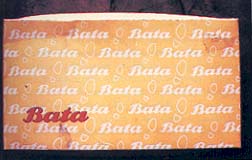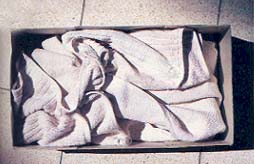The Temple Scroll—The Longest and Most Recently Discovered Dead Sea Scroll
How it affects our understanding of the New Testament and early Christianity
033
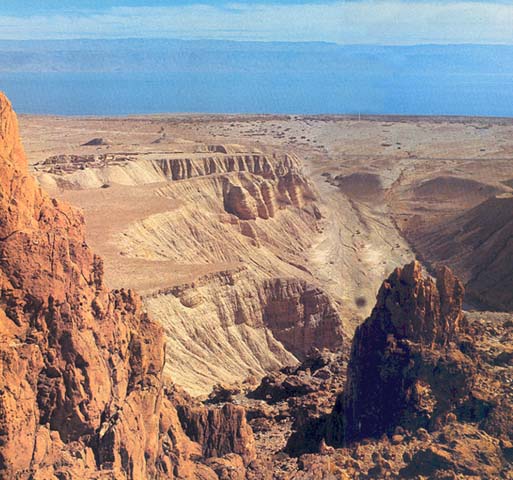
On August 1, 1960, I received a letter from a man who identified himself as a Virginia clergyman. The letter stated that the writer was in a position to negotiate the sale of “important, authentic discoveries of Dead Sea Scrolls.” Obviously, he contacted me because of my intimate involvement in Israel’s acquisition of the original Dead Sea Scrolls six years earlier.
034
In a subsequent letter, Mr. Z, as I shall refer to him, indicated the price for an entire scroll would be around one million dollars, since the Jordanian dealer who possessed the material (and here he named a well-known dealer involved in previous transactions for the purchase of Dead Sea Scrolls, whom I shall call “the dealer”) “knows their true value.” I informed Mr. Z of my willingness to negotiate only if the price was reasonable in comparison to the price paid to the Metropolitan Samuel for the original Dead Sea Scrolls.
An exchange of correspondence ensued, and on October 7, I purchased from Mr. Z—or through him—a fragment of the Psalms Scroll from cave 11 at Qumran. The pieces adjacent to this fragment were in the Rockefeller Museum, and how Mr. Z obtained this fragment—before the other fragments were obtained by the museum, or after—we shall never know. In any event, it was clear he had access to authentic materials from the Dead Sea Scroll caves.
Then on May 29, 1961, Mr. Z wrote that he had for sale not a fragment but an entire scroll. Moreover, the price was realistic: $100,000. On June 1, 1961, I replied that I would try to raise the $100,000 and would be in touch with him soon.
Shortly thereafter, I left for London, where I spent some time on sabbatical. There, by letter of August 9, 1961, Mr. Z informed me that he had clarified all details of the sale with the dealer and that the scroll in question was a large one: “nine inches wide, about 15 to 18 feet long.” Since, as Mr. Z said in his letter, a purchaser would no doubt be concerned with the authenticity of the scroll, he was enclosing a fragment which had broken off from the scroll.
I examined the envelope and found a fragment of a scroll wrapped in tin foil from a package of cigarettes. The back of the fragment was reinforced with a piece of a British postage stamp.
I immediately saw that the fragment was authentic!
It did not surprise me that Mr. Z would send me the fragment like this. He had previously sent me the Psalms Scroll fragment in a Manila envelope wrapped in a napkin, trusting me to send him the money.
In his letter Mr. Z asked me to make an evaluation of the new fragment and send it back to him by return mail—which is exactly what I did. I advised Mr. Z that the fragment seemed to belong to a genuine scroll of the Dead Sea type and was written by a good scribe.
On August 29, 1961, Mr. Z wrote back that the asking price for the scroll was now $750,000.
Angered by this increase in price, I replied that his letter “baffled and infuriated me since it indicates you never took seriously what I told you regarding the price … If things remain as you state in your letter, I am afraid you can rule me out as a customer.”
Soon thereafter I left England for the United States where wearisome and often detailed negotiations continued with Mr. Z.
Finally, a deal was struck. The agreed price was $130,000. An intricate six-page agreement to be signed by the dealer was drafted by a lawyer. The agreement provided that prior to payment we would examine the scroll itself for authenticity and for its correspondence to the fragment. We also agreed on a $10,000 down payment, which I gave to Mr. Z, and he in turn once again gave me the fragment I had returned to him so that I could eventually compare it to the entire scroll. I also gave Mr. Z $1,500 to finance a trip to Bethlehem, then under Jordanian control, which he said was necessary to conclude the agreement with the dealer.
The agreement prepared by the lawyer was never signed by the dealer. On December 1, 1961, I received a letter from Mr. Z saying that difficulties had arisen: The price was now $200,000. Since I had the fragment, he decided to hold the $10,000 “in order to work in good faith on both sides since you have the all-important piece.”
Further correspondence ensued in January and February 1962, Mr. Z asking for further advances and I trying to get back the $10,000.
The last letter received from Mr. Z was on May 17, 1962. He again made “promises” and again pleaded for more money. That was the last we ever heard from him.a
036
I consoled myself with the thought that at least I had the fragment. I tried to put the matter out of my mind but obviously could not. In 1963 I began my excavations at Masada, Herod’s desert fortress and the place where the Zealots made their last stand against the Romans. This excavation was a consuming interest, but I nevertheless continued to peruse the scientific archaeological publications concerning the scrolls, wondering whether I would find some reference to a new Dead Sea Scroll. Nothing appeared, however.
If Masada was not enough to put the matter out of my mind, the Six-Day War in June 1967 was. I was then serving as military advisor to the Prime Minister. On June 7, the Israel Defense Forces captured the Old City of Jerusalem and Bethlehem. Suddenly, I recalled the scroll. The dealer involved had a shop in East Jerusalem and lived in Bethlehem. Both he and his scroll might be within Israeli jurisdiction! I immediately reported this to Prime Minister Levi Eshkol, who put at my disposal a lieutenant-colonel from military intelligence.
After I briefed the lieutenant-colonel about the supposed scroll and the fragment in my possession, he went to the dealer’s shop and informed him of the scroll fragment we had obtained from Mr. Z. After brief negotiations, the dealer agreed to take the officer to his home in Bethlehem. There, the dealer removed from beneath some floor tiles a shoe box containing the scroll. He also produced a cigar box containing fragments that had become detached from the scroll. Later, it was discovered that the dealer had hidden additional fragments behind family pictures, both in his own home and in his brother’s home.
The military government confiscated the scroll and fragments in accordance with Jordanian law governing antiquities. Although the dealer had illegally concealed the scroll’s existence from the Jordanian authorities and had kept it under dreadful conditions that caused extensive damage, especially to the upper part of the scroll, it was nevertheless decided to pay him for the scroll—for the simple reason that we want to encourage such people to come forward if they have additional scroll materials.
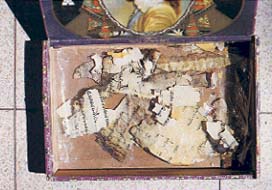
The amount finally agreed upon with the dealer, after negotiations lasting almost a year, was $105,000.
Unfortunately, I was given the job of raising the money. This task proved not to be so onerous, however, because of the generosity of Mr. Leonard Wolfson of Great Britain, who contributed $75,000 for this purpose. The balance was paid by the Israeli Government.
Thus ended the saga of the scroll’s acquisition. The saga of its unrolling began.
I first held the scroll in my hands on the evening of Wednesday, June 8, 1967, the day Israeli forces united East and West Jerusalem. On June 11, the war was over, and we started the task of unrolling the scroll shortly thereafter. The work was done under the direction of Joseph “Dodo” Shenhav of the Israel Museum, who is already familiar to BAR readers as the author of an article on the preservation of the Israel Museum’s Dead Sea Scrolls.b

The first part of the scroll we unrolled was a separate wad we call Wad Y, which had been wrapped in cellophane inside the shoebox. The fragments in this wad turned out to be the beginning of the extant part of the scroll. Letters and even words had peeled off some of the columns of script and attached themselves, in mirror image, on the backs of preceding columns (the scroll was rolled with the end on the innermost core). The first extant column of Wad Y had the imprint from a preceding but now lost column; unfortunately, the mirror image was so faint I could not decipher the letters. I could conclude only that there must have been at least one earlier column, so I called the first extant column II. Wad Y contained columns II through V.
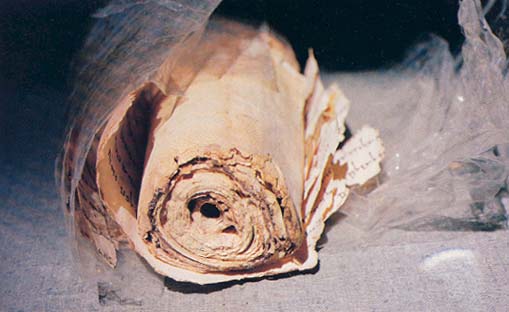
Next we tried to unroll what we call Wad X, which contained columns VI through XIII. Wad X had been rolled so tightly that at times the entire text was preserved in mirror image on the back of the previous column. Sometimes the text was preserved only in this manner.
037
Other wads were slowly and carefully separated and pieces gradually fitted together and into the main text, based on the contours of the edges. In the end, we were left with a wad consisting of a black macerated mass containing the remnants of two or three columns, but we could neither separate it nor decipher the letters. We photographed the amorphous mass from every angle, with different lightings, with regular, orthochromatic and infrared film—all with negligible results.

Fortunately, the scroll proper was for the most part easier to unroll than the wads. In general, we used the process developed by H. J. Plenderlieth to open the original Dead Sea Scrolls—softening the outer roll by a process of humidification at 75 to 80 percent. When this process did not work, we used another developed by Plenderlieth—applying nearly 100 percent humidity for several minutes, immediately followed by a few minutes of refrigeration. In some cases, we could not use this process, however, because the adjacent writing was in such fragile condition it would have been damaged by the process. In 039such cases, we had no choice except to leave the pieces stuck together and try to salvage their contents with photographs from back and front against the light. Occasionally, we were compelled to cut the columns lengthwise, a kind of plastic surgery, and then to rejoin them after their separation.
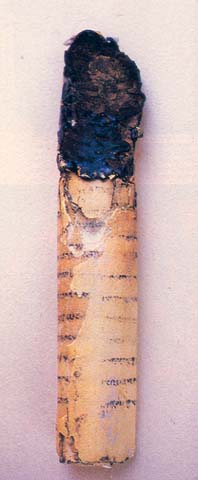
The animal skin on which the scroll is written is extremely thin, indeed the thinnest I have ever encountered. Nowhere is it more than one-tenth of a millimeter thick. Nevertheless, and despite the use of a sharp instrument, the scribe was able to rule in guidelines (so-called “drylines”) without making cuts in the skin. Two different hands, called Scribe A and Scribe B, have been detected in the script.
As I have already indicated, the beginning of the scroll is missing, but we know that we have the end because there is a blank sheet at the end of the scroll, as is customary at the end of all Dead Sea Scrolls.
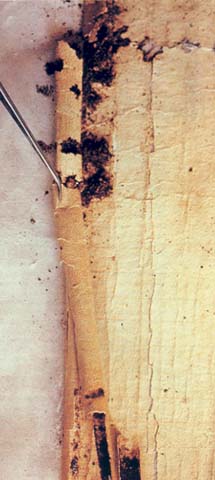
The scroll contains 66 columns of text and is 27 feet long. This makes it the longest of all the Dead Sea Scrolls. Previously, the great Isaiah Scroll—22 feet long—containing the entire text of the book of Isaiah—was the longest of the scrolls, which gives some idea of the length of the Temple Scroll.
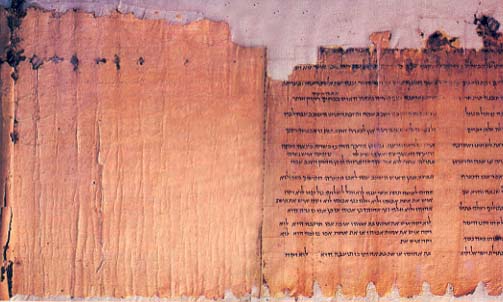
On the basis of the script, the scroll can be dated to the Late Herodian period, say mid-first century A.D. or a little earlier. But that is the date of this copy, not 040necessarily the date of the composition it contains.
I believe the date of the composition of the scroll, however, was much earlier—approximately 150–125 B.C. I have several reasons for this conclusion. One is that we found two unpublished fragments from Qumran Cave 4 in the Rockefeller Museum which came from other, earlier copies of this same composition. The earlier of these fragments was written in a Hasmonean script that can be dated to about the last quarter of the second century B.C. (about 125–100 B.C.), so our scroll could have been composed no later than this. Moreover, I believe I can detect historical allusions in the text that would confirm a dating of 150–125 B.C. This subject is treated at some length in my three-volume edition of the scroll.c
A more interesting question is, what was this composition? It is my belief that this scroll contains nothing less than the basic torah or law of the Essenes who lived at Qumran on the northwestern shore of the Dead Sea. For them it was a holy book, a part of the canon of what we call the Bible, the Torah of the Lord. Moreover, I believe the scroll was composed by the founder of the sect, the venerated Teacher of Righteousness.
I have several reasons for believing this document was the Essene torah, equal in importance to the traditional Torah, which they naturally also venerated as a holy book. Let me list some of the reasons for believing this scroll was the Essene torah.
The scroll contains long passages from the Pentateuch,d sometimes whole chapters, but the scroll is frequently written in the first person, with God himself speaking, instead of Moses referring to God in the third person, as is often the case in the parallel Pentateuchal passages. This change is accomplished by replacing the tetragrammatone LORD in the Pentateuch by “I” or “me” in the Temple Scroll. Even the supplementary laws in the Temple Scroll, which are not in the Pentateuch, are often written in the first person.
Thus, the text of Numbers 30:3 appears in the Temple Scroll as follows: “When a woman vows a vow to me. … ” Obviously, the author wished to present the Law as if handed down by God himself, rather than through the mouth of Moses.f
On the other hand, the tetragrammaton is also used in a number of instances in the Temple Scroll. These passages, however, also contain an important clue regarding the canonical or holy status of the Temple Scroll. To understand this clue, a little background is necessary.
Hebrew was originally written in a script scholars refer to as Old Hebrew, or Palaeo-Hebrew. When the Jews returned from exile in Babylon, they brought with them a square “Aramaic” script that gradually replaced the previously used script. However, the earlier Old Hebrew script continued to be used in certain archaizing contexts. For example, during the First and Second Jewish Revolts against Rome in 66–73 A.D. and 132–135 A.D., the Jews minted coins using the older Hebrew script on them. In the Dead Sea Scrolls, the tetragrammaton is sometimes written in the Palaeo-Hebrew script, although in general the scrolls themselves are written in the square script. There is a pattern in the Dead Sea Scrolls: the tetragrammaton is written in Palaeo-Hebrew in the midst of a text otherwise written in the square “Aramaic” text that was in common use at the time. In the Dead Sea Scrolls, the archaized, Palaeo-Hebrew tetragrammaton generally occurs in non-canonical, that is, non-Biblical,. texts. In the books of the Bible preserved at Qumran, the tetragrammaton is written, by contrast, in the square “Aramaic” script, just like the rest of the text.
In the Temple Scroll, when the tetragrammaton is 041used, it is written in the square “Aramaic” script, as in the Biblical books found at Qumran. This is another reason to believe that the Temple Scroll was considered by the Essene community as Biblical or canonical.
The subject matter and the fact that such a long scroll—nearly 30 feet—was copied several times at Qumran, as we know from the Rockefeller Museum fragments, also indicates that it was probably considered a holy book.
The Temple Scroll probably even contains excerpts from certain lost books referred to in the Bible, according to the Essene tradition, which are otherwise unknown. This again requires some background to understand.
While still in the wilderness, the Israelites were implicitly commanded to build a temple for the Lord once they were established in the Promised Land. For example, in Deuteronomy 12:10–11, we read:
“But when you go over the Jordan, and live in the land which the Lord your God gives you to inherit, and when he gives you rest from all your enemies round about, so that you live in safety, then to the place which the Lord your God will choose, to make his name dwell there, thither you shall bring all that I command you: your burnt offerings and your sacrifices, your tithes and the offering that you present, and all your votive offerings which you vow to the Lord.”
The building of the Jerusalem Temple was one of the most important tasks enjoined upon the Israelites in the wilderness. But the Bible contains no laws for the plan of the Temple. This is a startling omission. Despite detailed laws and descriptions of the Tabernacle and its utensils, the Torah gives no divine law concerning the plan of the Temple!
Later Biblical writers naturally noticed this unusual omission. The Chronicler explains:
“Then David gave Solomon his son the plan of the vestibule of the temple, and of its houses, its treasuries, its upper rooms, and its inner chambers, and of the room for the mercy seat; and the plan of all that he had in mind for the courts of the house of the Lord [and the details of all the sacred furniture]. … All this he made clear by the writing from the hand of the Lord concerning it, all the work to be done according to the plan.”
1 Chronicles 28:11–19.
All this was made clear in writing from the Lord? Where was this written in the Torah?
According to the rabbis, a scroll existed in which this Torah was written. They even called it the Temple Scroll (megillat beth ha-mikdash). It was given to David, said the rabbis, through Moses, Joshua and the prophets:
“The Temple Scroll which the Holy One Blessed Be He committed to Moses … , Moses … transmitted to Joshua … and Joshua to the Elders and the Elders to the Prophets and the Prophets to David and David to Solomon.”
Midrash Samuel, Buber ed., xv:3 (92)
The scroll we obtained in 1967 contains elaborate plans for the building of the Temple. Indeed, nearly half of the scroll is taken up with the plans for the Temple, sacrifices and the laws of the city of the Temple. That is why I decided to call it the Temple Scroll. I do not claim that this scroll contains the text of the scroll supposedly handed down to David (and definitely not the one the rabbis had in mind). But I do believe that the author of this part of the scroll was writing with knowledge of the existence of a Temple Scroll referred to obliquely in the book of Chronicles. Either believing that he was divinely inspired or basing his descriptions on an older tradition, he considered himself to be preserving this missing part of the Torah, referred to in the Biblical book of Chronicles. It is interesting to note that the Temple Scroll concentrates on precisely those elements detailed in the passage from Chronicles in which God’s missing laws for the plan of his Temple are described—the vestibule, the treasuries, the upper rooms, the inner chambers. In the Temple Scroll, God himself speaks in minute detail concerning his Temple to be built by the children of Israel. He is the Master Architect, supplying the plans missing from the Torah. At the end of days, in the New Creation, God himself will build the Temple.
Another major portion of the Temple Scroll—nearly four columns—is devoted to what I call the Statutes of the King. This portion of the scroll could also be called the Torah of the King or the Laws of the King or even the Constitution of the King. This portion of the scroll contains laws relating to the marriage of the king, rules for mobilization during war, limited rights of the king to booty in war, provision for an advisory council (consisting of 12 priests, 12 Levites and 12 lay Israelites), provision for subordinate administrative positions of authority, and other such matters. This too may be related to an otherwise unknown book referred to in the Bible.
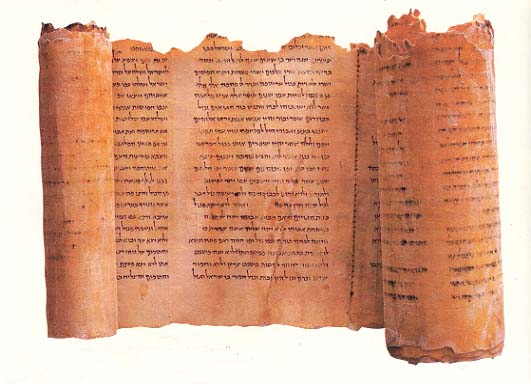
While still in the wilderness, the Israelites were commanded to appoint a king after they occupied the Promised Land (Deuteronomy 17:14–15). Yet here too there is a startling omission in the Torah. There is almost a complete absence of laws governing the king. There are a few verses in Deuteronomy 17:15–20 and in 1 Samuel 8:11ff. regarding the rights and duties of the king, but that is all. In 1 Samuel 10:25, however, we learn that “Samuel explained to the people the rights and duties of the king and he [Samuel] wrote it down in a book which he laid before the Lord.”
042
“What happened to this book?” Jews must have asked themselves. In my view, the author of the Temple Scroll believed he was writing down, in the sections of the Temple Scroll I have labeled Statutes of the King, the contents of this missing book, according to his tradition.
In this connection it is interesting that two of the principal points made in 1 Samuel 8:11–12 are that the king “will appoint for himself commanders of thousands and commanders of fifties” and that the king is entitled to a “tenth of your grain and of your vineyards [and] … of your flocks.” These two subjects are among the most important dealt with in the Temple Scroll’s Statutes of the King.
In Deuteronomy 17:18 we are told, “And when he [the king] sits on the throne of his kingdom, he shall write for himself in a book a copy of this law (mishneh ha-torah 043hazoth), from that which is in charge of the Levitical priests. …” This verse is generally considered by scholars to refer to the whole of Deuteronomy, that is, the second copy of the Law or Torah. The rabbis, or at least some of them, understood this passage to refer to a copy of the previous verses; there were also other speculations. But the author of the Temple Scroll used this verse from Deuteronomy to introduce the Statutes of the King. When he quotes this passage, however, he omits the word “copy,” so instead of its being a “copy of this law,” it reads in the Temple Scroll as if it were the Law itself: “When he [the king] sits on the throne of his kingdom, they [the priests] shall write for him this law in a book from that which is in the charge of the priests.” Then, as if to emphasize the point, the Temple Scroll adds: “And this is the Law.” The Statutes of the King follow.
044
For all these reasons, it seems clear to me that the Temple Scroll was, for the Essenes, a holy canonical book on a par, for them, with the other books of the Bible.
In a short article, it would be impossible to describe in detail the entire contents of the Temple Scroll. The best I can do here is to provide a summary.
The Temple Scroll is above all a book of the Law, laws for the community both for the present and for the time when the true heirs of the Zadokite priesthood would again reign in Jerusalem. I have referred to the long passages relating to the Temple, its plan, its furniture and utensils, its sacrifices and other cultic laws. I have also referred to the Statutes of the King. Other long sections describe various festivals or holy days, many of which are “additional” holidays not mentioned in the Bible, such as the New Barley festival, the New Wine festival, the New Oil festival (all first-fruits festivals), and the Wood-Offering festival. Other more familiar festivals whose observance is described in the Temple Scroll include the Feast of Booths and the Day of Atonement. Sometimes the observances are the same as those described in other sources; sometimes they are different. Other laws relate to such things as idolatry, vows and oaths, pure and impure animals, ritual impurities, laws of testimony, and so forth.
I have already mentioned some of the characteristics of the scroll: the frequent use of the first person when God speaks, the tetragrammaton (when it appears) in the square “Aramaic” script as in other Biblical Dead Sea Scrolls, and the Herodian and the Hasmonean letter forms which help to date the scroll. Let me allude to a few other characteristics of the scroll.
The author of the scroll is clearly an expert on the text of the Pentateuch. He often merges passages from 045different parts of the Bible that deal with the same subject into a single smooth-flowing text. Unlike the Bible, the scroll is arranged according to principal themes—the Temple, the festivals, the Statutes of the King, etc., and it brings together disparate Pentateuchal passages bearing on these themes.
More important, the author often harmonizes and unifies duplicate, different, and sometimes even conflicting Biblical laws. In case of simple duplication, the scroll will combine the two texts by contractions and deletions. This approach is in contrast with that of the rabbis who taught, “Whenever a scriptural passage is repeated, it is because of some new point contained in it” (Babylonian Talmud Sota 3a).
When several Biblical passages deal with the same subject but their texts contain different, non-conflicting laws, the scroll will combine them into a single integrated text.
For example, in Deuteronomy 12:23–24, the people are commanded to refrain from eating blood; it must be thrown on the ground like water. In Leviticus 17:13, the blood is to be covered with earth. In the Temple Scroll, the two commands are combined: “Blood you shall not eat; you shall pour it on the ground like water; and cover it with earth.”
When there are conflicts in Biblical passages, the scroll will often harmonize them, sometimes by splitting the difference.
Perhaps the overriding characteristic of the laws in the Temple Scroll is their strictness. I shall discuss here one of the most important applications of this principle of strictness. The principle of strictness, however, permeates the entire scroll.
The Pentateuch describes the rules of ritual cleanliness applicable to the Israelite camp in the wilderness (e.g. Deuteronomy 23:10–14). How are these laws of ritual cleanliness to be applied after the wilderness tabernacle has been replaced by the Jerusalem Temple and the wilderness camp by the city of Jerusalem? In the approach taken by normative Judaism, the rabbis ruled that the Holy City of Jerusalem was to be divided into three different camps: The Temple proper (the Divine camp), the area surrounding the Temple (the Levitical camp), and the rest of the city (the Israelite camp). According to rabbinical interpretation, the harshest bans are applicable only to the Temple proper, the less harsh are applicable to the area surrounding the Temple, and the remainder are applicable to the entire city. To achieve this tripartite division, the rabbis gave different interpretations to different occurrences of the word “camp” in the Biblical text. But these interpretations were not suggested by the text itself. The rabbis applied them in order to ameliorate the harshness that would result if all the restrictions applicable to the wilderness camp were applied uniformly to the entire city of Jerusalem—indeed to other cities as well. The rabbis who resorted to this tripartite division of restrictions by interpreting “camp” in three different ways were—if you wish—the “Reform Jews” of their day in comparison to the Essenes.
The Essenes, as we learn from the Temple Scroll, would have none of this. For them, the City of the Temple (Jerusalem) was equated with the camp where the tabernacle was kept in the wilderness.g All the laws and bans applicable to the wilderness camp were applicable to the entire city of Jerusalem. (In some cases, the camp is equated with any city, and the bans are applicable to all cities.)
We would consider some of the results quite bizarre. For example, in Deuteronomy 23:12–14, we are told there is to be a place outside the camp in the wilderness for defecation. The Essenes applied this injunction literally to the entire city of Jerusalem. The Temple Scroll forbids the building of toilets in the city:
“You shall make a place for the hand (a toilet) outside the city to which they shall go out … 3,000 cubits [outside the city] in order that it will not be visible from the city.”
A similar rule is found in another of the Dead Sea Scrolls known as the War Scroll. Because 3,000 cubits is beyond the limit of permitted walking on the Sabbath, Essenes who lived in Jerusalem could not walk to the latrines on the seventh day—and they therefore refrained from relieving themselves on the Sabbath.
Interestingly enough, Josephus, the first-century Jewish historian who in his youth lived among the Essenes in Qumran, confirms that they observed these rules—defecating only outside their settlement and refraining from defecation on the Sabbath. Josephus also describes a city gate in Jerusalem, mentioned nowhere else, that he calls the Essene Gate. This may well be the colloquial name for the gate the Essenes used to go out (or rather, to run out … ) of the city to relieve themselves. Since the Temple Scroll prescribes the building of public toilets “northwest of the city,” this reference provides an important clue as to the location of the Essene Gate. Josephus mentions that near the Essene Gate was a place called Betsoa, which is obviously Beth-Soah in Hebrew, i.e., a lavatory.
The Essenes applied other bans to the entire city of Jerusalem, according to their interpretation of the Biblical rules of purity related to the camp. Thus all sexual 046relations were banned in the city of Jerusalem. (This may perhaps explain the fact that the Essenes were celibate. Moreover, this may be the origin of celibacy as a doctrine.) People afflicted with impurity were forbidden from entering Jerusalem and were confined instead to specially built structures east of the city.
The Dead Sea Scrolls are without doubt one of the most important discoveries, if not the most important discovery, for Biblical studies ever made in the Holy Land. Their discovery created shock waves among scholars. To change the metaphor, it was as if a powerful telescope with a zoom lens suddenly brought the world of Judaism at the end of the Second Temple period into immediate focus across a barrier of 2,000 years. This period was both a tragic turning point in Jewish history—the Romans destroyed the Temple in 70 A.D.—and the cradle in which Christianity was born and began to grow. The Temple Scroll, like the previously discovered Dead Sea Scrolls, will no doubt be scrutinized by generations of scholars in order to illuminate this critical period in the history of Judaism as well as Christianity.
Since we cannot consider here even a fraction of the problems and insights contained in the Temple Scroll (many of which are discussed in my scientific edition of the scroll), what I would like to do is give a few examples of the way scholars might be using the Temple Scroll to broaden and enrich our understanding of the New Testament and early Christianity.h The importance of the Temple Scroll to Jewish and Biblical studies is more apparent and therefore will not be discussed here.
I have just discussed how strictly the scroll interprets Biblical laws. I mentioned the bans on entering the Holy City of Jerusalem, which the Temple Scroll equates with the Tabernacle camp in the wilderness. One of the locations in which the banned were to be isolated may give us a clearer picture of the nature of the place where Jesus stayed, at the house of Simon the Leper, before he entered Jerusalem (Mark 14:3; Matthew 26:6).
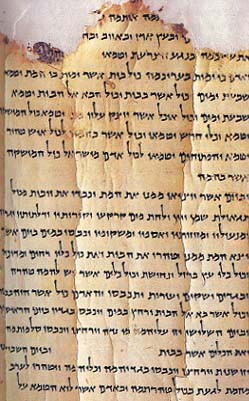
The Temple Scroll, of course, bans all lepers from Jerusalem, just as lepers were banned from the Israelite camp in the wilderness. As noted above, we are told (in Column 46):
“And you shall make three places east of the city … into which shall come the lepers and the people who have a discharge and the men who have had a (nocturnal) emission.”
From this and a similar passage, we learn that lepers must have been confined in a separate place east of the city. We know from the Midrashi that at this time it was thought leprosy was carried by the wind. The prevailing wind in Jerusalem is westerly—from west to east. Therefore, the rabbis prohibited walking east of a leper. According to the Temple Scroll, lepers were placed in a colony east of the city to avoid the westerly wind’s carrying the disease into the city. In my view, Bethany (east of Jerusalem on the eastern slope of the Mount of Olives) was a village of lepers. Thus, it was not that Jesus just happened to stay in the house of a leper (Simon) before he entered Jerusalem; he deliberately chose a village of lepers. This deliberate choice would have compounded the offense—entering Jerusalem after contact with lepers—in the eyes not only of the Essenes but of the Pharisees as well.
From the doctrinal viewpoint, the influence of the Essenes on early Christianity, as has been noted by various scholars, is more complicated. We must distinguish between the various layers, or strata, to use an archaeological term, of early Christianity. The theology, the doctrines and the practices of Jesus, John the Baptist and Paul, for example, are not the same. The Dead Sea Scrolls shed new light on these differences.
The similarity between the sectarian doctrines reflected in the Dead Sea Scrolls and in early Christianity were, of course, noted immediately after their discovery. Indeed, one of the chief surprises of the Dead Sea Scrolls for some Christians was that some of what were previously thought to be innovative Christian doctrines and practices were in fact known to the Essenes one hundred or two hundred years before Jesus’ time.
But these facts must be related to different sources of Christian doctrine. Jesus himself was, in my opinion, quite anti-Essene, as he was anti-Pharisee. Jesus reacted against the strict insistence on ritual purity practiced not only by the Pharisees but even more so by the Essenes.
Indeed, there may well be an anti-Essene reference in the Sermon on the Mount, as was already noted by the Austrian scholar Kurt Schubert. Jesus there says to the multitude, “You have heard it said … hate thine enemy. But I say to you, love your enemies” (Matthew 5:43–44). This passage is somewhat of an enigma. Who is it that has said, “Hate your enemy”? We are not told. There is no such doctrine in any Jewish writing. But, as Schubert has shown, in one of the basic texts of the Qumran community called the Manual of Discipline, new members of the sect swear an oath of allegiance to love the Sons of Light (that is, the members of the Essene community) and to hate for all eternity the Sons of Darkness. The reference in the Sermon on the Mount to those who advise hating your enemies may well be to the Essenes and would thus 047reflect Jesus’ own anti-Essene stance.
Another enigmatic passage from the New Testament, Mark 8:14–21, may be clarified by the Temple Scroll itself and as we shall see, in a manner that reflects Jesus’ anti-Essene position. In the pericope from Mark, Jesus is in a boat on the Sea of Galilee, with only a single loaf of bread. He cautions his disciples, “Beware of the leaven of the Pharisees and the leaven of the Herodians.” The disciples are concerned at the lack of bread. Jesus berates them:
“Having eyes do you not see, and having ears do you not hear? And do you not remember?”
Jesus recalls for them the miracle of the multiplication of the bread:
“‘When I broke the five loaves for the 5,000, how many baskets full of broken pieces did you take up?’
They said to him, ‘Twelve.’
‘And the seven for the 4,000, how many baskets full of broken pieces did you take up?’
And they said to him, ‘Seven.’
And he said to them, ‘Do you not yet understand?’”
Modern readers have no less difficulty understanding. The passage is full of obscurities. But the Temple Scroll may help us penetrate some of the cruxes: Who were the Herodians and what is the significance of the 12 baskets full of pieces and the seven baskets full of pieces? And why were the disciples supposed to infer that these baskets full of pieces were an allusion to the bread of the Pharisees and the bread of the Herodians?
I previously referred to the many “new” or additional festivals referred to in the Temple Scroll. These were observed by the Essenes but not by normative Jews. One of these additional festivals I did not mention was the annual seven-day celebration known as the Days of the Ordination (or consecration) of the Priests. This celebration is patterned on the seven-day consecration ceremony Moses performed on Aaron and his sons when they became priests of the Lord in the wilderness, as described in Leviticus 8. For normative Judaism, this ordination of the priests was a one-time act. No new consecration or ordination ceremony of this kind was performed on Aaron’s descendants. For the Essenes ruled by the Temple Scroll, however, this was a yearly ceremony It was to be performed annually, forever. So the Temple Scroll tells us. The role of Moses was to be taken by the High Priest. When the High Priest himself was to be consecrated, the role of Moses was to be performed by the priestly Elders. The details of the ordination ceremony are spelled out in great detail in the Temple Scroll. They are quite complicated, but here we need focus only on one aspect. Leviticus 8:2 speaks of one basket of bread used for the offering on each of the seven days of the ceremony. In the Temple Scroll, however, there are seven baskets of bread, one for each day. Indeed, it appears from the Temple Scroll that the Essenes had a special ceremony connected with the seven baskets of bread, although they could not then offer the full sacrifice at the Jerusalem Temple because it was not built according to their plan; it was not pure according to their laws, and the priests were not legitimate according to their view.
Now let us return to the passage in Mark. Jesus tells his disciples to beware of the bread of the Pharisees and the Herodians. He then refers to the miracle of the 12 baskets of bread and the seven baskets of bread. The 12 baskets, I think, alludes to the Pharisees who controlled the 048Jerusalem Temple. Each week the priests ate the 12 loaves of the presence (Leviticus 24:5–9). In effect Jesus is saying, Do not concern yourself with the 12 loaves in the Pharasaic temple; I created 12 baskets of bread for you.
But what of the seven loaves of the Herodians? What does this allude to? In my view, this refers to the seven loaves the Essenes used in the annual seven-day ceremony of the ordination of the priests. Jesus is telling the disciples not to concern themselves with the Essenes either. Jesus miraculously creates the seven baskets of bread of the Essenes, as well as the 12 baskets of bread of the Pharisees.
But, you may say, the passage from Mark refers to the seven baskets of the Herodians, not the seven baskets of the Essenes. I believe when Jesus refers to the Herodians, he really means the Essenes. I suspect that the Essenes had the nickname “Herodians.” Josephusj tells us that Herod was in effect the protector of the Essenes and showed special kindness to them. The suggestion that the Herodians mentioned in Mark, and elsewhere, refer to the Essenes has been made before, but now, from the Temple Scroll, we have considerable evidence for the similarity between Essene beliefs and Herodian beliefs, which strengthens the identification of the Herodians with the Essenes.
Perhaps we can now reply more intelligently to the question Jesus asks: “Do you not yet understand?” Jesus rejects the strict interpretations of the Essenes, as well as the Pharisees. Thus, here again we see Jesus taking an anti-Essene stand.
John the Baptist’s relationship to the Essenes is quite different from Jesus’. John may even have been a member of the Essene community. He was active in the area around Qumran; he, like the Essene community at Qumran, was celibate; and he was from a priestly family. Moreover, the type of baptism he was preaching, which gave John his name, was also practiced by the Essenes. We know that the Essenes practiced baptism not only from their literature but also from the baptismal installations found at Qumran.
These baptismal installations are quite different from the ritual baths (mikvaot) of the period found, for example, at Masada, in the Jericho area, and in Jerusalem. The normative Judaism ritual baths had to contain “living” water; that is, water either from the rain or from a flowing stream or river. Since this was not available year round, especially in the desert, ritually pure water was saved and preserved in a reserve pool adjacent to the ritual bath. A channel led from the reserve pool to the bath pool so that a small amount of the living water would be added to each bath to purify it, so to say. The Jewish ritual baths are characterized by these twin pools. At Qumran, however, there is only a single pool (with steps) in which people could be baptized.
Baptism as we know it in early Christianity may have been adopted under Essene influence through John the Baptist.
But the most often noted similarities between Christianity and Essene doctrine came not from John the Baptist, and certainly not from Jesus. The principal similarities are to be found in the Pauline Epistles and in the Johannine literature. How do we explain these similarities—such things as the dualism found both in the New Testament and in the writings of the Dead Sea sect, the contrast between the Sons of Darkness and the Sons of Light (a term often used in the Pauline literature), the spirit and the flesh, good and evil. The communal meal is also something we find in early Christianity and in the Dead Sea sect. It is my belief that these similarities came through Paul.
Paul was himself a Pharisee before his conversion on the road to Damascus, but he surely knew well the doctrines of all the sects he was persecuting, including the Essenes. Paul became the apostle to the Gentiles. He was attempting insofar as possible to avoid the burden of the Mosaic law for those whom he converted and who found the Mosaic law an obstacle to their new allegiance. Paul’s problem was how to be a Jew without the restrictions of the Mosaic law. I think he found a ready-made theology in many respects in the doctrines of the Essenes. For the 049Essenes, like early Christians (but for different reasons), rejected the Jerusalem Temple and its cult: In my view, the striking similarities between early Christianity and the doctrines of the Essenes entered Christianity after Jesus’ time via Paul in the period before the Romans destroyed the Jerusalem Temple in 10 A.D. (and Qumran for that matter).
Yet there is a paradox here: How can it be that a sect (the Essenes) that adhered so tenaciously to the strictest and most legalistic interpretation of all the minutiae of the Law of Moses as prescribed in the Torah, could influence—of all sects—that one (Christianity) which in due course essentially rejected this Law, especially those parts of the Law concerned with Temple observance and ritual purity?
The complete answer is no doubt more complicated than the following hesitant outline suggests, but it is in this area that I believe the answer to our paradox is to be found. As I have said, the early Christians came into contact with the Essenes and were influenced by them at a time late in Essene history (first century A.D.). They met Essenes who maintained their own calendar and repudiated the Jerusalem Temple as well as its laws, for reasons mentioned. Thus bereft of a legitimate temple, the Essenes developed a theology and religious practice that enabled them to live without this cultic institution, especially at their own monastic centers such as Qumran in the wilderness. The following paraphrase of Proverbs 15:8 from an Essene document could have appealed to circles of Pauline or Johannine Christianity: “The sacrifice of the wicked is an abomination, but the prayer of the just is an agreeable offering” (Damascus Document 11:20–21).
The Essenes’ rejection of the Jerusalem Temple and its cult, like that of the early Christians, permitted the Essenes to influence the early Christians. Without a temple, the Essenes developed a way of life that was a kind of substitute for the Temple and worship in it. It was this way of life and the theology it reflected that appealed to and influenced the early Christians.
But for the Essenes, the rejection of the Temple was temporary. For them, the Jerusalem priests were illegitimate and the Temple polluted because their own rigid legal interpretations of the Law were not applied; even its plan was a wrong one. For the Essenes, the temporary, substitute way of life was applicable only until “the exiles of the Sons of Light return from the Wilderness of the Nations to encamp in the Wilderness of Jerusalem” (War Scroll 3).
What was a temporary substitute for the Essenes, Christianity adopted as a permanent theology, part of their fixed and final canon. In short, what was for the Essenes an ad hoc adaptation to their rejection of the Jerusalem priesthood and Temple, applicable only until the end of days when the Temple would be rebuilt by God according to their own beliefs, became for Christianity a permanent solution. Thus, the historical paradox by which the early Christians could be so heavily influenced by a legalistic sect, despite the fact that Christianity itself rejected this legalism.
Let me conclude simply with a few puzzles in the history of Christianity for which the Temple Scroll might provide the hint of a solution.
Of course, even before the acquisition of the Temple Scroll, we knew about the solar calendar used by the Essenes, which contrasted with the lunar calendar practiced by normative Judaism. The Essenes’ solar calendar was divided into four sections consisting of three 30-day months, plus one additional day. Thus, the Essene year contained 364 days, divided into twelve 30-day months, plus four intercalated days inserted at the end of each three-month group. (In the course of years, this calendar would need additional intercalated days—or leap years—to maintain the same seasons, but we have no information, for the time being, on how the Essenes did this.) Using this calendar, however, results in holidays always falling on the same day of the week.
I have already mentioned the many “new”—or previously unknown—holidays described in the Temple Scroll, including three new (and one well-established) “first fruits” festivals. The Essenes reckoned the date on which each of these festivals began by counting 50 days after a particular Sabbath (counting the day of the preceding festival as the first day of the new counting), with the result that these festivals always began on a Sunday. Sunday thus begins to appear as a most important day.
In the Statutes of the King, the Temple Scroll considers restrictions on the king’s marriages. Rabbinic Judaism interpreted Deuteronomy 17:11 to restrict the king to 18 wives. This was based in part on the fact that King David had 18 wives.
In contrast, the Temple Scroll provides:
“[The King] shall not take another wife, for she [his first wife] alone shall be with him all the days of her life. But should she die, he may take unto himself another wife.”
Here we have a clear-cut ruling against bigamy and divorce, the earliest such ruling in any extant Jewish writing. This may well have been a forerunner of Christian doctrine on these subjects.
As my readers will have noted, I have raised more questions than I have answered. But the scholarly riches of the Temple Scroll have just begun to be mined.
048
Only 2,000 Copies Printed of English Edition of Yadin’s Temple Scroll
If you want to own the English edition of The Temple Scroll, buy it now or very likely face disappointment later. Yadin’s three-volume set has been printed in both a Hebrew and an English edition. The Hebrew edition is already sold out. Volume III, containing the plates of the scroll, is the same in both editions; it is printed in both Hebrew and English. However, only 3,000 copies of Volume III were printed at the time the Hebrew edition was printed. Of these, 1,000 volumes of plates were used for the Hebrew edition. Only 2,000 of the volumes were then left for the English edition, thus limiting the print run of the English edition despite a demand now known to be in excess of this number. The 2,000 English sets that were printed early this year will very likely sell out as quickly as the Hebrew edition did. If you want to own the English edition of the Temple Scroll, order your copy from BAR Discount Books now.
On August 1, 1960, I received a letter from a man who identified himself as a Virginia clergyman. The letter stated that the writer was in a position to negotiate the sale of “important, authentic discoveries of Dead Sea Scrolls.” Obviously, he contacted me because of my intimate involvement in Israel’s acquisition of the original Dead Sea Scrolls six years earlier. 034 In a subsequent letter, Mr. Z, as I shall refer to him, indicated the price for an entire scroll would be around one million dollars, since the Jordanian dealer who possessed the material (and here he named […]
You have already read your free article for this month. Please join the BAS Library or become an All Access member of BAS to gain full access to this article and so much more.
Already a library member? Log in here.
Institution user? Log in with your IP address or Username
Footnotes
I am still keeping his confidence, however, by not revealing his name. I want all these people—whether they are robbers or not (and it is a cloak-and-dagger business) to know that as far as I am concerned, if they tell me not to reveal their identities, I won’t. Otherwise, we have no chance of getting more scrolls. And I believe there still might be another scroll or some fragments here or there. For the same reason, I don’t call the dealer by name, even though many know who he is.
“Preserving the Dead Sea Scrolls For the Next 2,000 Years,” BAR 07:04. Shenhav also wrote “Loaves and Fishes Mosaic Near Sea of Galilee Restored,” BAR 10:03.
The Temple Scroll, edited by Yigael Yadin (The Israel Exploration Society, The Institute of Archaeology of the Hebrew University of Jerusalem, The Shrine of the Book Jerusalem, 1977), 3 volumes. (See review in Books in Brief in this issue.)
The tetragrammaton is the ineffable and unpronounced name of God, consisting of the four consonants YHWH, often transcribed in English literature as Yahweh.
“Although Moses is never mentioned by name in the existing columns of the scroll, it is clear that God is speaking to Moses, as we know, for example, by a reference to “Aaron your brother” (column 44, line 5).
This is apparently spelled out in a still unpublished letter from Qumran that, according to the editors, was sent by the Teacher of Righteousness himself. The letter is to be published by John Strugnell and Elisha Qimron. See “Jerusalem Rolls Out Red Carpet for Biblical Archaeology Congress,” BAR 10:04.
The literature on the Essene-Christian relationship is vast; some of the very best discussions are contained in K. Stendhal (ed.), The Scrolls and the New Testament (New York, 1957).

